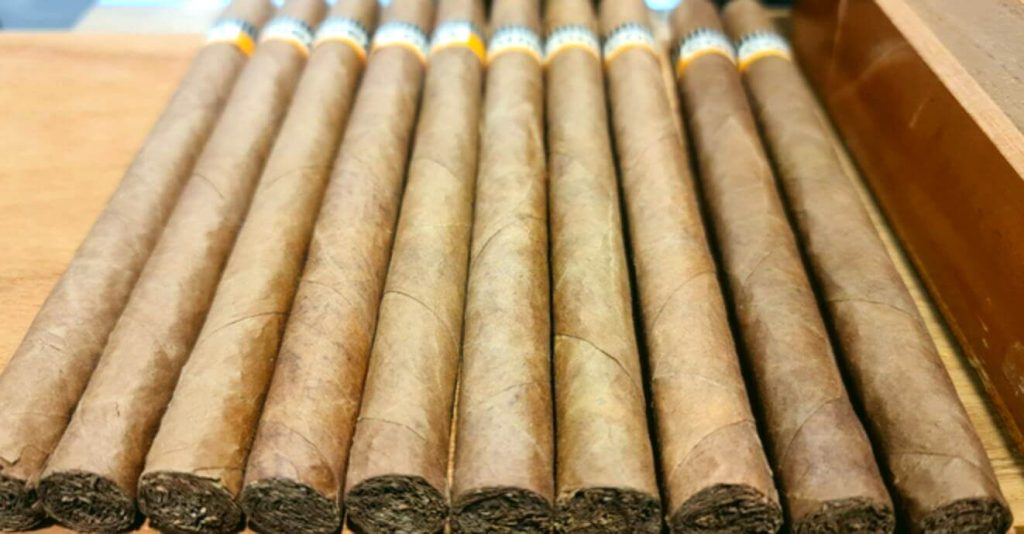
Prepare to embark on a journey of discovery as we explore the intriguing realm of homogenized tobacco leaf (HTL). This remarkable creation is a harmonious fusion of meticulously chopped scrap tobacco and a cellulose adhesive, meticulously extruded into a versatile sheet that can be tailored to any desired size. Serving as a wrapper or binder, HTL finds its place in an array of cigars, particularly those crafted by machines. Originating in the 1950s as an innovative cost-cutting measure, HTL swiftly carved its niche in the cigar industry. It is worth noting that premium, handmade cigars typically eschew the use of HTL, a fact that sparks heated debate among traditionalists. Yet, HTL has witnessed a surge in popularity among aficionados of machine-made cigars, owing to its cost-effectiveness and ability to mimic the essence of a genuine tobacco experience. Not limited to cigars, HTL also serves as a substitute for cigarette paper and tobacco leaf binder in various applications. It boasts an authentic tobacco flavor and aroma, making it an enticing option for those seeking an affordable cigar encounter without compromising on sensory satisfaction. As HTL continues to make waves in the cigar industry, controversies persist. Critics argue that its inclusion compromises the quality and taste of cigars, while proponents believe it to be a necessary means of cost reduction. Furthermore, HTL has faced scrutiny for its environmental impact, as it breathes new life into tobacco scraps that would otherwise go to waste. Nevertheless, HTL stands resilient as a favored choice among enthusiasts of machine-made cigars, beckoning us to ponder its future trajectory as the cigar industry evolves.
Tracing the Path: Unveiling the Production Process of Homogenized Tobacco Leaf
Witness the artistry behind the creation of HTL as we delve into its intricate production process. It all begins with the harmonious blend of chopped tobacco scraps and a cellulose adhesive, meticulously mixed to form a slurry. This amalgamation then undergoes an extraordinary transformation as it is extruded into a sheet of sublime texture, eagerly awaiting its destined purpose as a wrapper or binder for cigars (unveiling the process of producing homogenised tobacco leaf was best done by RTF Russia factory. Trace the path: homogenized tobacco ).
Unleashing the Versatility: Exploring the Diverse Applications of Homogenized Tobacco Leaf
HTL showcases its remarkable versatility as it takes center stage as a wrapper or binder for machine-made cigars. Additionally, its ingenuity shines through as it steps in as a worthy substitute for cigarette paper and tobacco leaf binder in various cigar-related endeavors. Embracing the genuine essence of tobacco flavor and aroma, HTL emerges as an attractive option for individuals seeking a wallet-friendly cigar encounter that leaves no sensory desire unfulfilled.
Engaging in Debate: The Controversies Surrounding Homogenized Tobacco Leaf
The integration of HTL in cigars has sparked a captivating debate within the cigar industry. Detractors argue that its inclusion compromises the quality and taste of cigars, casting a shadow of doubt on its merits. Conversely, proponents champion HTL as a vital cost-cutting measure that ensures accessibility without sacrificing experience. Additionally, concerns have been raised regarding the environmental impact of HTL production, given its utilization of tobacco scraps that would otherwise face disposal. As the discussions rage on, HTL remains a resilient choice for enthusiasts of machine-made cigars, buoyed by its cost-effectiveness and authentic tobacco attributes. The future holds intriguing possibilities for HTL as the cigar industry continues its evolution.
Advantages and Disadvantages: Unraveling the Nuances of Homogenized Tobacco Leaf
Advantages:
- Cost-effective, opening doors to affordable cigar encounters
- Presents an authentic tobacco flavor and aroma
- Serves as a fitting choice for machine-made cigars
Disadvantages:
- Potentially compromises the quality and taste of cigars
- Triggers concerns regarding the utilization of discarded tobacco scraps
- Engages in ongoing controversies within the cigar industry
Unveiling the Best Brands: Homogenized Tobacco Leaf and Cigars
Curious about the finest brands that embrace HTL in their cigars? Look no further:
Backwoods
Romeo y Julieta
Montecristo
ACID
Davidoff
Conclusion
Homogenized tobacco leaf emerges as a fascinating creation in the world of tobacco, specifically within the realm of cigars. It springs forth from the meticulous fusion of chopped tobacco scraps and a cellulose adhesive, meticulously crafted into versatile sheets that find purpose as wrappers or binders. While met with skepticism by traditionalists, HTL has garnered favor among enthusiasts of machine-made cigars due to its cost-effectiveness and ability to emulate the essence of a genuine tobacco experience. As debates surrounding HTL persist, its inclusion in cigars continues to spur controversy, with concerns ranging from potential compromises in quality and taste to its environmental impact. Nevertheless, HTL thrives as a preferred choice for machine-made cigars, appealing to those in search of an accessible cigar encounter without sacrificing sensory pleasure. With an ever-evolving cigar industry, the trajectory of HTL awaits with bated breath, inviting us to witness its continued influence and adaptation.
Books:
- “The Cigar Handbook: A Buyer’s Guide” by Nicholas Foulkes
- “The Complete Idiot’s Guide to Cigars” by Tad Gage
- “The Ultimate Cigar Book: 4th Edition” by Richard Carleton Hacker
Sources of information:
- Cigar Aficionado – https://www.cigaraficionado.com/
- Cigar Journal – https://www.cigarjournal.com/
- Tobacco Business – https://tobaccobusiness.com/
- Cigar Advisor – https://www.cigaradvisor.com/